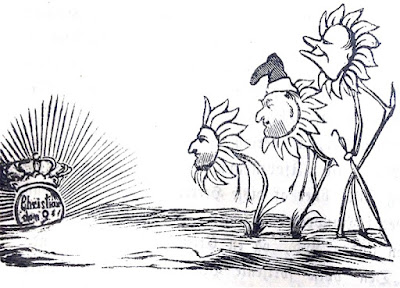Reiersen the Second
Pages for a new History of Political Cartooning in Denmark
 |
| Peter Klæstrup for Folkets Nisse, No. 14, April 7, 1866. The ultimate bending over was s favorite from the first cartoons before democracy |
1865 brought Heyman to the scene. In 1866 the brothers Otto and Frederik Algreen Ussing were appointed chamberlains to the king. The brothers were members of Augustforeningen (i.e. The August Society) and identified themselves as The Black Brother and The White Brother according to their hair color.
According to Folkets Nisse they were thus fittingly born with the Prussian colors.
 |
| Peter Klæstrup for Folkets Nisse, No. 79, September 11, 1852. Some seek protection from the rain, others expose themselves to it. |
But before the ruling, the then publisher or rather he who just happened to have his name on the magazine at that time, the bookseller F.V. Thomsen was already in trouble.
The Brothers Ussing had by way of the General Procureur Association made Thomsen sign an agreement that if the magazine in word or image, directly or indirectly were to comment in an improper manner on the King, Queen or their descendants of which the Ussings would be the judge, Thomsen would pay The Ussing Brothers 250 Rigsdaler.
 |
| Peter Klæstrup for Folkets Nisse, No. 43, November 10, 1866. "Dressed up to be seen by their majesties, maybe having the joy of being spat at, if only they would overlook the donkey ears". |
An agreement so outrageous that... but let us tell the tale of Thomsen first: In return, The Ussing Brothers would dismiss the court case. Thomsen was poor and he had got the reassurance that he needed.
Just about a week after the signing of the agreement, Pjerrot Jr. was of course overstepping the line stated - and the Ussing Brothers dragged Thomsen to court. Unable to pay 10 let alone 250 Rigsdaler, Thomsen ended up in debtor's prison.
Thomsen was jailed in October and was meant to be imprisoned for a year before the debt would have been paid off. He was released in November, however, in that in the meantime voices in the press spoke unequivocally: The Ussing Brothers were the guilty party. They had executed censorship.
 |
| Peter Klæstrup for Folkets Nisse, No. 15, April 14, 1866. The white brother and the black brother sucking up to the royal slipper. |
 |
| Peter Klæstrup for Folkets Nisse, No. 15, April 14, 1866: "The picture album of the young daughters of a baronet showing The Ussing Brothers in their new uniforms". |
The Ussing Brothers were in other words the old censor Reiersen all over again and were given the nick name Reiersen the Second.
The name was apt, but their enterprise was a serious matter.
It was private censorship.
Private censorship executed as a question of honor, which in fact could be turned against the King and Queen and their descendants considering an impoverished man was imprisoned in their name.
Given the opportunity The Ussing Brothers had set themselves above the King, running the country as they found it fit, deciding what was permitted and what was not.
The Ussing Brothers - still according to Folkets Nisse - would then ask if the magazine would enter The August Society since it would vastly improve the numbers of its members. The mention of the dwindling society, of course, had been one of the first grievances against Pjerrot Jr.
The Brothers would if so take up work for Folkets Nisse, offering to act as Reiersen the Second, paying Folkets Nisse 250 Rigsdaler every term for their trouble, if only they might censor and cut anything not to their liking and according to their sympathies for the royal court.
 |
| Peter Klæstrup for Folkets Nisse, No. 46, November 17, 1866. "Portraits of the outer part of Chamberlain Ussing and the nether part of student N.N. presented in the format of a call card". |
The story then took on how the editors of Folkets Nisse were winking at each other and joining in on the joke, for one it would be marked on the official calendar from then on that an unbelievable tie had been created between The August Society and Folkets Nisse.
The magazine would be allowed to continue writing as long as what was written was tasteless as water.
In return it would bring 300 new members for the otherwise failing August Society. Drinking into the night, it was decided that The Brothers would thenceforward be known as Reiersen den Anden or Reisersen the Second.
Folkets Nisse would continue to mock The Brothers, giving them the best answer to an attempt to undermine a democracy: writing openly and critically about those, whose enterprise in a weaker society might have been a dangerous one.
Frederik Algreen-Ussing was removed from a research project as a direct outcome of the revelation in the public. He was a corrupted man. He died a few years later.
The Ussing Brothers would soon be forgotten. It is perhaps the beauty of the tale.
 |
| Peter Klæstrup for Folkets Nisse, No. 52, December 29, 1866. HOW COULD YOU! Hr. Sørensen dealing with The Year 1866 when for one thing The Ussing Brothers were made chamberlains. |
Carl Ploug wrote on Thomsen's predicament in his daily Fædrelandet, October 10, 1866.







